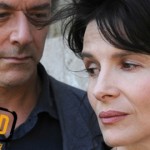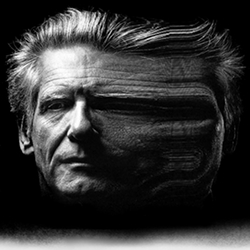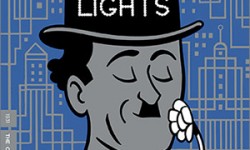
DVD Review: Certified Copy (2010)
Cast: Juliette Binoche , William Shimell , Jean-Claude Carrière
Director: Abbas Kiarostami
Country: France | Italy | Belgium
Genre: Drama
Official Trailer: Here
Purchase Now!
Editor’s Notes: Certified Copy was released 5/22/2012 on DVD and Blu Ray from Criterion.
Abbas Kiarostami’s Certified Copy, released by the Criterion Collection in a special two-disc set this week, finds him at his most playful in his ongoing exploration of the poetic, poignant lines that separate fiction and documentary, art and life, and now, original and copy. As in previous films like Close-up (1990) and those that constitute his “Koker” trilogy, especially Through the Olive Trees (1994), Kiarostami here puts his characters and narrative in that in-between space of being, which brings into the discussion the set of lines that separate filmmaker and spectator, intention and interpretation. In 2001, Kiarostami said to French philosopher Jean-Luc Nancy, “The only way to envision a new cinema is to have more regard for the spectator’s role.” Certified Copy is nothing short of an amazing, sensitive rumination on the enigmatic vagaries of feelings and relationships between men and women, in which the spectator plays an active role in the film’s de/construction of meanings.
As in previous films like Close-up (1990) and those that constitute his “Koker” trilogy, especially Through the Olive Trees (1994), Kiarostami here puts his characters and narrative in that in-between space of being, which brings into the discussion the set of lines that separate filmmaker and spectator, intention and interpretation.
 That Certified Copy begins in such an “uncinematic” way, as Kiarostami describes it in the making-of documentary film included in the two-disc set, marks the film’s playfulness. The opening shot is of a table, on top of which are several microphones and a book titled Copia conforme (the film’s title in Italian), whose subtitle is “Meglio una buona copia che l’originale” (A good copy is better than the original). Several seconds pass before a person enters the frame, then several minutes pass before the book’s author James Miller (played by English opera singer William Schimell) arrives to delivers a lecture. This opening sequence unfolds as James begins his lecture on art, translation, and the debated values of an original and/or a copy.
That Certified Copy begins in such an “uncinematic” way, as Kiarostami describes it in the making-of documentary film included in the two-disc set, marks the film’s playfulness. The opening shot is of a table, on top of which are several microphones and a book titled Copia conforme (the film’s title in Italian), whose subtitle is “Meglio una buona copia che l’originale” (A good copy is better than the original). Several seconds pass before a person enters the frame, then several minutes pass before the book’s author James Miller (played by English opera singer William Schimell) arrives to delivers a lecture. This opening sequence unfolds as James begins his lecture on art, translation, and the debated values of an original and/or a copy.
Yet once James begins his lecture, the film also begins to morph into something else. A woman (played by French actress Juliette Binoche) then enters the venue and takes a seat; then her son enters and remains standing on the side. (The woman is nameless in the film, so let us call her Juliette, for the simple reason that Kiarostami wrote the screenplay with Binoche in mind and doing so would add another layer to the film’s reflections on original and copy, art and life.) While the sound-track continues James’ lecture, the image-track shifts to Juliette and her son or Juliette and James’ translator. And with that, the film simply leaves the lecture to follow Juliette and her son. But the rest of the film is in fact a continuation of James’ lecture, as it delicately weaves the stages of Juliette and James’ relationship into discussions on originals, copies, art, perception, interpretation, illusion, and misunderstanding, which in turn are woven into the space of the small town of Lucignano.
The status of Juliette and James’ relationship when they leave for Lucignano the following day is limited to a writer and an antiques seller, or a writer and a fan. Yet the reactions that they provoke in one another reveals a little bit the possibility of another relationship underneath the one that is currently manifested. As characters conversing in a car in a Kiarostami film is like nothing else, Juliette and James’ drive to Lucignano sets into motion a variant of the original-copy debate, that of object-perception, or the idea of the value in the way of looking as opposed to the object of one’s looking—which describes what Kiarostami does in and through his cinema.
The status of Juliette and James’ relationship when they leave for Lucignano the following day is limited to a writer and an antiques seller, or a writer and a fan. Yet the reactions that they provoke in one another reveals a little bit the possibility of another relationship underneath the one that is currently manifested.
 When they arrive at Lucignano, actually a popular site for weddings, Juliette and James’ relationship further morphs into multiple shapes, in accordance with the spaces of Lucignano that they visit: the portrait titled “Original copy,” or Musa Polomnia, in a museum; a café; the crypt that houses the work The Tree of Life, where newlyweds take photos; the bronze statue of a man and a woman in a plaza; the trattoria with a wedding party, a church, and a hotel. The café sequence is the heart of the film, for it is the dramatic and narrative turning point for James, Juliette, and the spectator, and their perceptions of each other, further deepening the mystery of Juliette and James. Are they playing a game, recalling a shared past, or acting out naturally? What about Kiarostami playing with his characters and the spectator, such as his fabricated story of Musa Polomnia being a copy? Is there such a thing as an original or ideal, or is one ordained to a mise en abyme of reproductions, copies, and ‘false’ ones, each of which nevertheless possesses their own relative value?
When they arrive at Lucignano, actually a popular site for weddings, Juliette and James’ relationship further morphs into multiple shapes, in accordance with the spaces of Lucignano that they visit: the portrait titled “Original copy,” or Musa Polomnia, in a museum; a café; the crypt that houses the work The Tree of Life, where newlyweds take photos; the bronze statue of a man and a woman in a plaza; the trattoria with a wedding party, a church, and a hotel. The café sequence is the heart of the film, for it is the dramatic and narrative turning point for James, Juliette, and the spectator, and their perceptions of each other, further deepening the mystery of Juliette and James. Are they playing a game, recalling a shared past, or acting out naturally? What about Kiarostami playing with his characters and the spectator, such as his fabricated story of Musa Polomnia being a copy? Is there such a thing as an original or ideal, or is one ordained to a mise en abyme of reproductions, copies, and ‘false’ ones, each of which nevertheless possesses their own relative value?
At bottom, what Juliette and James experience together at any given point in the film is both true and false, an echo of a possibly shared past and the sketch of something new, a manifestation of change and sameness, from the time they officially meet in Juliette’s cavernous, underground antique shop to the moment when they are three floors above the ground in the hotel room where they may have spent their honeymoon fifteen years ago. Watching all that transpires in between is as exciting, exquisite, and open-ended as feeling a loved one’s hand on one’s shoulder.
DVD extras:
Apart from the film, disc one contains a trailer. It makes the film look like a facile romantic comedy, which is rather startling to see right after the film and is like an extratextual joke on the original-copy debate.
Disc two contains invaluable extras, though to call them “extras” is a bit insulting. It includes a new interview with Kiarostami, in which he talks about the genesis of Certified Copy, how a copy allows one to understand the original, in love and art, and his 1977 film The Report, which could be the ‘original’ to Certified Copy. On this note, Godfrey Cheshire’s enclosed essay is a fantastic reading of Certified Copy, comparing the film to Roberto Rossellini’s Viaggio in Italia (1954), for instance, in dialogue with Kiarostami’s interview.
Disc two also includes a fifty-minute documentary film on the making of Certified Copy by Irene Bufo, with in-depth interviews with Kiarostami, Binoche and Schimell, cinematographer Luca Bigazzi, and producer Angelo Barbagallo. Great to see Kiarostami interacting with his cast and crew and his discussion of the ease, joy, synchronicity, and comfort that he experienced while making the film.
Last but not least, disc two includes The Report, the abovementioned, rarely seen feature by Kiarostami. According to him, the original negative print of the film was burned during the Iranian revolution. This copy of the film was culled from a worn, English-subtitled print. Despite gaps in subtitles from time to time, the resulting copy as seen here is not that bad. In fact, one feels insanely lucky to have these two Kiarostami films together. The original and the copy? Up to you to figure out which is which, if that point even matters. What matters is that it is Kiarostami.
Related Posts
![]()
Rowena Santos Aquino
![]()
Latest posts by Rowena Santos Aquino (see all)






























